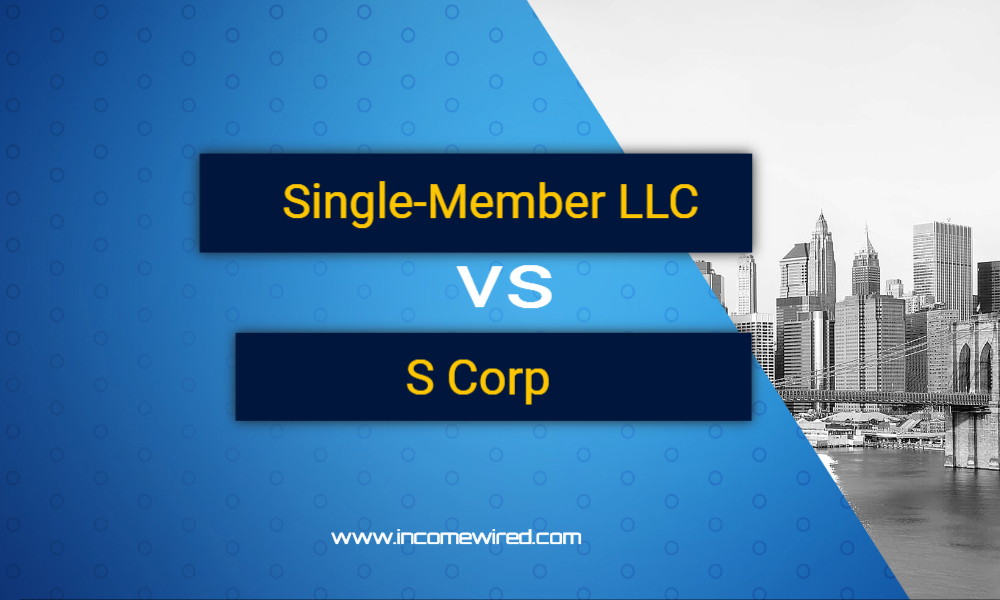we help service-based business owners, freelancers, and aspiring businesses with our content & services & When readers purchase services discussed on our site, we often earn affiliate commissions that support our work. Find out more about Income Wired
Starting a business is a multi-step process, and one of the first decisions you’ll need to make is what type of business entity to establish.
There are several different types of business entities, but two of the most common are multi-member LLCs and single-member LLCs. So, what’s the difference between these two types of LLCs? We will explore the key differences between multi-member LLCs and single-member LLCs in this article.
What is the definition of a multi-member LLC?
multi-member LLCs are business entities that have more than one owner. These businesses can be owned by a variety of individuals, including natural persons (i.e., human beings), trusts, estates, other LLCs, and corporations. In most cases, multi-member LLCs will file taxes as a partnership.
What is the definition of a single-member LLC?
A single-member LLC is an LLC that has only one owner. As the name suggests, single-member LLCs can be owned by only one individual (natural person), trust, estate, other LLC, or corporation. Single-member LLCs file taxes as sole proprietorships.
Key Differences Between Multi-member and Single-member LLCs
The key difference between multi-member LLCs and single-member LLCs is that multi-member LLCs have more than one owner while single-member LLC can have only one owner. Multi- member LLCs are owned by a variety of individuals, including natural persons, trusts, estates, other LLCs, and corporations. On the other hand, single -member LLCs can be owned by only one individual, trust, estate, other LLC, or corporation.
How Does a Single Member LLC Operate?
A single-member LLC is a limited liability company with only one owner. The business is its own separate legal entity from the owner, meaning the owner will not be held personally liable for debts or obligations of the business.
How Does a Multi-Member LLC Operate?
multi-member LLCs are just like any other limited liability company, except that they have more than one owner. As with any other LLC, multi-member LLCs offer their owners limited liability protection. This means that the owners of a multi-member LLC are not personally liable for debts or obligations of the business.
Multi-member LLCs can either be member-managed or manager-managed. In a member-managed multi-member LLC, all of the owners participate in the day-to-day operations and decision-making of the business. In a manager-managed multi-member LLC, on the other hand,
The management structure of a multi-member LLC is typically set forth in the operating agreement.
Benefits of a Single Member LLC
There are several benefits of operating as a single-member LLC, including:
- Fewer formalities and paperwork: Single-member LLCs have fewer formalities and paperwork requirements than multi-member LLCs. For example, multi-member LLCs are required to prepare and file annual reports with the state, while single-member LLCs are not.
- Flexibility: Single-member LLCs offer more flexibility than multi-member LLCs in terms of management and decision-making.
- Because there is only one owner, the owner of a single-member LLC has complete control over the business. The owner can make all of the decisions about how the business will be run without having to consult with or get approval from other members.
- Simplicity: Single-member LLCs are simpler to operate than multi-member LLCs. This is because there is only one owner, which means there are fewer people involved in the decision – making process.
Benefits of a Multi-Member LLC
There are several benefits of operating as a multi-member LLC, including:
- Limited liability protection: Multi-member LLCs offer their owners limited liability protection, just like any other LLC. This means that the owners of a multi-member LLC are not personally liable for debts or obligations of the business.
- Tax benefits: Multi-member LLCs can elect to be taxed as partnerships, which offers certain tax benefits. For example, multi-member LLCs can pass income and losses through to the owners, which allows the owners to report them on their personal tax returns.
- Flexibility: Multi-member LLCs offer more flexibility than single-member LLCs in terms of management and decision-making. This is because multi- member LLCs can have multiple owners, each of whom can participate in the decision-making process.
Drawbacks of a Single Member LLC
There are several drawbacks of operating as a single-member LLC, including:
- Limited liability protection: Although single-member LLCs offer their owners limited liability protection, this protection is not absolute. For example, if the owner of a single – member LLC personally guarantees a debt of the business, the owner may be held liable for that debt.
- Self-employment taxes: The owners of single-member LLCs are subject to self-employment taxes, which can be significant.
- Increased paperwork: Single-member LLCs are required to file more paperwork with the state than multi-member LLCs. For example, single-member LLCs are required to prepare and file annual reports, while multi-member LLCs are not.
Drawbacks of a Multi-Member LLC
There are several drawbacks of operating as a multi-member LLC, including:
- Increased paperwork: Multi-member LLCs are required to file more paperwork with the state than single-member LLCs. For example, multi-member LLCs are required to prepare and file annual reports, while single-member LLCs are not.
- Potential for disagreements: Because multi-member LLCs have multiple owners, there is a greater potential for disagreements among the owners about how the business should be run.
- Reduced flexibility: Multi-member LLCs offer less flexibility than single-member LLCs in terms of management and decision-making. This is because multi-member LLCs must consult with and get approval from all of the members before making any decisions about the business.
Who Can Own A Multi-Member LLC?
Multi-member LLCs are businesses that have more than one owner. These businesses can be owned by individuals, other LLCs, or even corporations. Single-member LLCs, on the other hand, are businesses that have only one owner. The owner can be an individual, another LLC, or a corporation.
Multi-member LLC vs Single-member LLC
One of the main differences between multi-member LLCs and single-member LLCs is that multi-member LLCs are taxed as partnerships, while single-member LLCs are taxed as sole proprietorships. This means that multi-member LLCs must file a partnership tax return (Form 1065), while single-member LLCs must file a personal tax return (Form 1040).
Another difference between these two types of LLCs is that multi-member LLCs must have an Operating Agreement, while single-member LLCs are not required to have one. An Operating Agreement is a legal document that outlines the ownership and management structure of an LLC. It also sets forth the rules and regulations that the members of an LLC must follow.
How is a Single Member LLC tax?
Single member LLCs are taxed as sole proprietorships. This means that the owner of the LLC will report all of the income and expenses of the business on their personal tax return (Form 1040). The owner will also be responsible for paying self-employment taxes on their share of the profits.
How is a Multi-Member LLC taxed?
Multi-member LLCs are taxed as partnerships. This means that the LLC will file a partnership tax return (Form 1065) and each member will receive a Schedule K-1 detailing their share of the profits or losses. The members of the LLC will then report their share of the profits or losses on their personal tax return (Form 1040). The members of the LLC will also be responsible for paying self-employment taxes on their share of the profits.
How to Register for a single member LLC
The first step in forming a single-member LLC is to choose a business name. The name of the LLC must include the words “Limited Liability Company” or the abbreviations “L.L.C.” or “LLC.” It is also advisable to choose a name that is distinctive and easy to remember.
Once you have chosen a name for your LLC, you will need to file the Articles of Organization with the secretary of state in the state where you plan to do business. The Articles of Organization are simple document that includes the name and address of the LLC, the names and addresses of the members, and the duration of the LLC. In some states, you may also be required to include the purpose of the LLC in the Articles of Organization.
After the Articles of Organization have been filed, you will need to obtain an Employer Identification Number (EIN) from the IRS. The EIN is used to identify the LLC for tax purposes and can be obtained by completing an online application on the IRS website.
Once you have obtained your EIN, you will need to open a business bank account in the name of the LLC. This account will be used to deposit revenue and pay expenses related to the business. It is important to keep personal and business finances separate in order to maintain the limited liability status of the LLC.
Finally, you will need to obtain any licenses or permits that are required to operate your business in your state. The requirements for business licenses and permits vary from state to state, so it is important to check with your local Chamber of Commerce or the Small Business Administration to find out what is required in your area.
How to register for a multi-member LLC
The first step in forming a multi-member LLC is to choose a business name. The name of the LLC must include the words “Limited Liability Company” or the abbreviations “L.L.C.” or “LLC.” It is also advisable to choose a name that is distinctive and easy to remember.
Once you have chosen a name for your LLC, you will need to file the Articles of Organization with the secretary of state in the state where you plan to do business. The Articles of Organization are simple document that includes the name and address of the LLC, the names and addresses of the members, and the duration of the LLC. In some states, you may also be required to include the purpose of the LLC in the Articles of Organization.
After the Articles of Organization have been filed, you will need to obtain an Employer Identification Number (EIN) from the IRS. The EIN is used to identify the LLC for tax purposes and can be obtained by completing an online application on the IRS website.
Once you have obtained your EIN, you will need to open a business bank account in the name of the LLC. This account will be used to deposit revenue and pay expenses related to the business. It is important to keep personal and business finances separate in order to maintain the limited liability status of the LLC.
Finally, you will need to obtain any licenses or permits that are required to operate your business in your state. The requirements for business licenses and permits vary from state to state, so it is important to check with your local Chamber of Commerce or the Small Business Administration to find out what is required in your area.
Frequently Asked Questions:
What is more common a multi-member LLC or a single-member LLC?
There is no definitive answer to this question as it depends on the specific business and state requirements. However, in general, multi-member LLCs are more common than single-member LLCs. This is because multi-member LLCs offer several advantages over single-member LLCs, including the ability to raise capital more easily and the ability to provide each member with limited liability protection.
Are a husband and wife considered a multi-member LLC?
Yes, a husband and wife can be considered a multi-member LLC. This is because they are two separate individuals with distinct ownership interests in the business. As such, they would each be considered a member of the LLC.
Do multi-member LLCs have to be registered with the state?
Yes, all LLCs, including multi-member LLCs, must file the necessary paperwork with the state in which they plan to do business. This typically includes filing Articles of Organization and obtaining an Employer Identification Number (EIN) from the IRS. failure to do so can result in hefty penalties.
Can two people be on a single-member LLC?
No, two people cannot be on a single-member LLC. This is because the LLC must have a single owner who has complete control over the business. However, it is possible for two people to form a multi-member LLC. In this case, each individual would be considered a member of the LLC and would have an equal ownership stake in the business.
In Summary:
Choosing between a multi-member LLC and a single-member LLC will depend on a number of factors, including the size and structure of your business, your tax liability, and your personal preferences. If you are unsure which type of LLC is right for you, it is advisable to speak with an attorney or accountant who can help you weigh the pros and cons of each option.
So, which type of LLC is right for you? If you’re starting a business with one or more partners, then a multi-member LLC may be the best option. If you’re going solo, then a single-member LLC may be the way to go. Either way, it’s important to consult with an experienced business attorney to ensure that you’re making the best choice for your new business.



